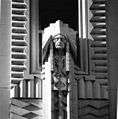Julius Theodore Melchers

Julius Theodore Melchers (1829–1908) was a German born American sculptor and teacher who immigrated to the United States leaving Prussia after 1848 and resided in Detroit, Michigan after 1855 .[1][2] During the Gilded Age, he became a "sculptor of great renown in the Detroit area."[3] The Julius T. Melchers House (1897) by Donaldson and Meier is located at 723 Seyburn, in the Indian Village Historic District on which Julius carved the ornate gable.[1][3] The likelihood that Melchers left Europe, as did so many other in and after the turbulent year of 1848 for political reasons is somewhat supported that he named his son (called, "Gari") after the famous Italian patriot and revolutionary Garibaldi.
Birth and emigration
Julius Theodore Melchers, was born in Soest, Westphalia, Prussia At age fifteen, while still in Prussia, Julius T. Melchers studied carving then studied at the Ecole des Beaux Arts in Paris with Carpeaux and Étex.[2] Before moving to the United States he worked as a modeler at the Crystal Palace in London as well as carving ships figureheads.[4]
Children
He had at least three children: one was Hettie Melchers, who married Julius Stroh of the Stroh brewing family in June 1883. The couple lived in an Italianate mansion on E. Jefferson Ave across from Van Dyke. His son, Gari Melchers, born in 1860, was an artist.[1] [5][6] The third child was Julia Melchers, who married Spencer Otis of Barington Ill.
Stroh Brewing Company
Julius T. Melchers served as Vice President of B. Stroh Brewing Company.[7]
According to Nawrocki and Holleman, Julius T. Melchers was Detroit's first sculptor.[8] Bela Hubbard (1814–1896), a lumber baron and real estate mogul, commissioned Julius T. Melchers to carve the "larger than life" sandstone statues of Detroit's four French pioneers, Fr. Jacques Marquette, Sieur de LaSalle, Antoine Cadillac, and Fr. Gabriel Richard installed in 1874 on the old Detroit City Hall (1871).[8] Architect John M. Donaldson had created the model Melchers had used for the statue of Marquette.[8] When the old Detroit City Hall was demolished in 1961 the statues were saved and moved to the campus of Wayne State University.
Photo gallery
-

Marquette
-

Cadillac
-

LaSalle
-

Richard
Notes
- 1 2 3 Baulch, Vivian M. (January 31, 1998).Detroit is fertile ground for art. Michigan History, The Detroit News. Retrieved on June 14, 2008.
- 1 2 Ferry, W. Hawkins (1968). The Buildings of Detroit: A History. Wayne State University Press, pp 78-79.
- 1 2 Hill, Eric J. and John Gallagher (2002). AIA Detroit: The American Institute of Architects Guide to Detroit Architecture. Wayne State University Press. ISBN 0-8143-3120-3.
- ↑ Gibson, Arthur Hopkin, Artists of Early Michigan: A Biographical Dictionary of Artists Native to or Active in Michigan, 1701-1900, Wayne State University Press, Detroit, 1975
- ↑ "Gari Melchers, Artist, Dead. Succumbs Suddenly to Heart Attack at 72 at His Estate in Virginia. Widely Known Since 1887. Recipient of High Honors Here and in Europe, His Paintings Hang in Many Galleries.". New York Times. December 1, 1932. Retrieved 2008-06-29.
- ↑ Columbia Encyclopedia Sixth Edition (2008).Melchers, Gari. Retrieved on June 14, 2008.
- ↑ Blum, Peter H. (1999). Brewed in Detroit: Beers and Breweries since 1830. Wayne State University Press. ISBN 0814326617.,p. 63.
- 1 2 3 Nawrocki, Dennis Alan and Thomas J. Holleman (1980). Art in Detroit Public Places. Wayne State University Press. p. 114.
References
 This article incorporates text from a publication now in the public domain: Chisholm, Hugh, ed. (1911). Encyclopædia Britannica (11th ed.). Cambridge University Press.
This article incorporates text from a publication now in the public domain: Chisholm, Hugh, ed. (1911). Encyclopædia Britannica (11th ed.). Cambridge University Press.- Ferry, W. Hawkins (1968). The Buildings of Detroit: A History. Wayne State University Press.
- Hill, Eric J. and John Gallagher (2002). AIA Detroit: The American Institute of Architects Guide to Detroit Architecture. Wayne State University Press. ISBN 0-8143-3120-3.
- Nawrocki, Dennis Alan and Thomas J. Holleman (1980). Art in Detroit Public Places. Wayne State University Press.
